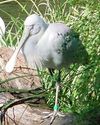Genus Platalea
Roseate Spoonbill - The Roseate Spoonbill is a gregarious wading bird of the ibis and spoonbill family, Threskiornithidae. It is a resident breeder in South America mostly east of the Andes, and in coastal regions of the Caribbean, Central America, Mexico, and the Gulf Coast of the United States.
African Spoonbill - The African Spoonbill occurs in marshy wetlands with some open shallow water, nesting in colonies in trees or reedbeds. It does not usually share colonies with storks or herons. Usually two to four eggs are laid.
Yellow-billed Spoonbill - It nests in trees, marshes or reed-beds, and often roosts in trees. It occurs in shallows of fresh wetlands and occasionally on dry pasture. It feeds largely on aquatic life, which it finds by sweeping its bill from side to side. Like all members of the ibis and spoonbill family, it always flies with its head extended.
Spoonbill - This species is almost unmistakable in most of its range. The breeding bird is all white except for its dark legs, black bill with a yellow tip, and a yellow breast patch like a pelican. It has a crest in the breeding season. Non-breeders lack the crest and breast patch, and immature birds have a pale bill and black tips to the primary flight feathers. Unlike herons, spoonbills fly with their necks outstretched.
Black-faced Spoonbill - The global population of this species, based on the winter population count carried out in 1988-1990 in all known sites, was estimated at 288 individuals. As of 2006, thanks to conservation efforts over the years, the estimated global population had increased to 1,679 . The niche population of North Korea does not exceed 30 birds, which implies that there must be another colony which has not been discovered yet, and which is perhaps located in northeast China; for example, on the islands of Liaoning .
Royal Spoonbill - The Royal Spoonbill is a large white bird with a black, spoon-shaped bill. It is a wading bird and has long legs for walking through water. It eats fish, shellfish, crabs and amphibians, catching its prey by making a side-to-side movement with its bill.






